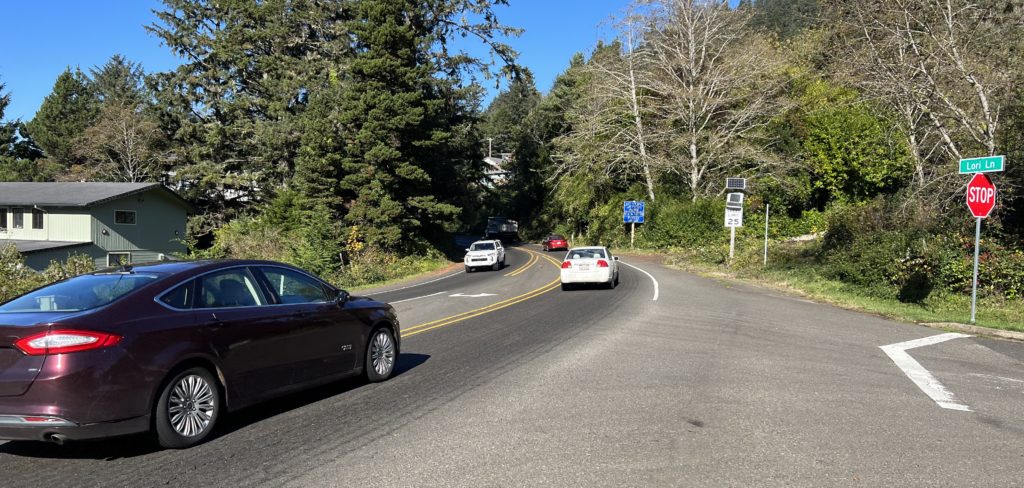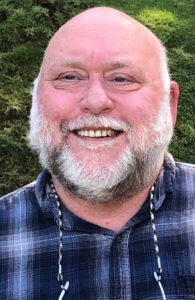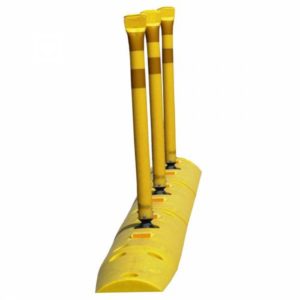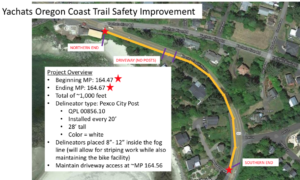
By DANA TIMS/YachatsNews.com
A 1,000-foot-long traffic project just south of downtown Yachats will make the town a testing ground for new safety measures not just locally, but all along the 370-mile Oregon Coast bike route.
If the installation of next-generation “delineators” slows cars and boosts safety for cyclists and pedestrians traveling along U.S. Highway 101, the traffic separators could soon be popping up in narrow, congested areas up and down the coast.

“We’ve had a lot of complaints from people feeling unsafe along there,” said Rick McClung, the city’s streets and water supervisor. “So we’re happy to be the guinea pig for this new technology.”
The state of Oregon is providing $40,000 to pay for materials and installation. McClung told the city’s Public Works & Streets Commission last month that there was a small surprise in the agreement with the Oregon Department of Transportation – it would pay $20,000 up front and then reimburse the city the remaining $20,000 after the delineators were installed.
After that, the city has agreed to take over maintenance of the delineators. Installation is expected to be completed by next summer.

The delineators, also known as “candlesticks,” poke up vertically out of plastic polymer curbing. They are 28 inches in height and will be placed about one foot inside the highway’s west-side fog line.
“The idea is that drivers will see the delineators and not drift across the fog line,” McClung said. “The speed limit there is 25 miles per hour, but motorists are tending to hit the gas because they think they’ve left the Yachats city limits behind them.”
The project area extends from Ocean View Drive south to Bayview Terrace.
A pilot project
As much as the traffic-calming effort will aid local pedestrians, it will also benefit the estimated 6,000 to 10,000 people who ride the Oregon Coast Bike Route annually, said Jenna Berman, an Oregon Department of Transportation staffer in Corvallis who helps the agency decide and plan on pedestrian and bicycle projects for the region.
“We are working with the city to try something that really hasn’t been tried a lot along the coast,” she said. “It’s definitely something of a pilot project.”
The route runs from Astoria south to Brookings and, according to surveys, generates more than $56 million in tourism spending. However, a number of gaps exist in terms of cycling safety, Berman said.
The Yachats project is just one example of where planners are trying different approaches to make the route more comfortable for both cyclists and pedestrians hiking the 382-mile-long Oregon Coast Trail.
The Yachats delineators will also help determine how durable the new technology is over time.
“We are really hoping it holds up well and can be used for years to come,” Berman said. “We are learning as we go, but this project represents an important test for how we can address other problem spots along the route.”
Longer-term fix

What amounts to a second phase of the current plan calls for widening the highway’s right-of-way to extend full new sidewalks from downtown Yachats to the bridge over the Yachats River.
McClung said that plan is nowhere near anyone’s front burner, but added that ground could be broken on the extension sometime within the next five years.
The cliff on the highway’s east side would need widening, he said, while a retaining wall would need to be built to stabilize the hillside and protect pedestrians.
Theoretically, he added, someone could then start walking south on the 804 Trail at the Adobe motel north of town, arrive in Yachats and proceed along Ocean View Drive. They would then come out onto the highway and head south on new sidewalks, crossing the bridge before turning down Yachats Ocean Road.
“What a beautiful trail they’d have,” McClung said.
And if they were in decent physical condition, he said, they could continue on up to Cape Perpetua, all without ever having to deal directly with cars.
“It will totally tie north and south Yachats together,” McClung said.
- Dana Tims is an Oregon freelance writer who contributes regularly to YachatsNews.com. He can be reached at DanaTims24@gmail.com




It’d be good to have a passive cross walk — lines, not lights — at Lori Lane and Highway 101 to allow pedestrians cross the highway into and out of Quiet Water.
I miss the days when we encouraged personal responsibility instead of creating artifical barriers at every turn where instead of admiring nature we are surrounded by man-made objects that detract from nature… a case for being safe vs feeling safe. I would rather support and importantly, encourage a consistent effort to crack down on speeding through ALL of town I can’t tell you how many times I felt more unsafe than walking in town as cars speed in north and south AND especially speed out. Artificial barriers are being placed where it is basically impossible to gain enough speed to create physical harm in areas where there are no cases of accident or injury. I drive through many communities on the coast where speed limits are strictly observed. In Waldport I often see a Sheriff’s or OSP patrol unit. What are they doing right and what can we do to take more responsibility and create accountability rather than overuse the power and tools of protection?
I have walked the highway many times and fully support this initiative. Your assertion that cars can’t gather enough “speed gain enough speed to create physical harm in areas where there are no cases of accident or injury” is wrong. https://one.nhtsa.gov/About-NHTSA/Traffic-Techs/current/ci.Literature-Reviewed-On-Vehicle-Travel-Speeds-And-Pedestrian-Injuries.print#:~:text=One%20estimate%20is%20that%20about,over%2050%20mph%20at%20impact. I agree that speeding is problem all over town. That fact doesn’t exclude the need to address the danger posed by the lack of pediatrician/cyclist separation from the highway on south side of town.
I have repeatedly been almost hit and had to step out of the way or pull my kids away from the edge to escape the harm from some car going over the line because drivers are failing to pay attention or can’t see around the blind turn coming out of town. Car and even 18 wheels routinely go between 35-40 mph along this stretch as you can witness from the speed monitor on the north bound lane. Bravo to the town and especially Rick in addressing this issue with at least some barrier and I look forward to a sidewalk. I would support more barriers (planters) and even speed bumps in this dangerous area.
The primary reason I volunteered for the Public Works and Streets Commission this year was to do something about the dangerous curve on Highway 101 that connects north and south Yachats. As an active walker, I believe this stretch of highway is dangerous. Therefore, to avoid this stretch of highway and yet enjoy the sights offered by Yachats Ocean Road, I typically drive down from my home on Hanley. It would be so much nicer to simply walk from my house, but the danger presented to pedestrians along this stretch of highway is unacceptable in my opinion.
I want to say I’m heartened and happy to see ODOT get on board with our efforts, and Rick McClung should be given a strong pat on the back for managing this process.
That said, I would like to say that the delineators being proposed should be tall so that drivers of large RVs and trucks can clearly see them. They should also be reflective so that they’re easy to see at night. I have made this point in commission meetings.
The city’s next effort should be directed at slowing speeds on Highway 101 and throughout the city at large. I’ve asked the commission to consider a uniform speed limit for all city surface streets of 15 mph. This might be too high for narrow streets, but I believe it will be easy for folks to remember if there is only one speed limit for all surface streets. Furthermore, I’d like to see signage of this speed limit posted throughout the town. Regarding Highway 101, I’d like to see the speed limit reduced to 25 mph on the entire stretch of the highway through the city of Yachats. As folks know, at the north end and south ends of this stretch of highway, the speed limit rises to 40 mph, and this is simply too high and is not necessary to effectively move traffic through our town, as 25 mph does the same thing – but at a safer speed for pedestrians.
In my discussion with Yachats citizens, many have been vocal that reducing speeds is something that we should do but they say without adequate enforcement of speed limits, folks will just ignore posted signs. I too believe this. All indications are that speeds are violated regularly on 101 – not only in the designated 25 mph zone but also on the two 40 mph zones that bookend it.
I’ve reached out to the Lincoln County Sheriff’s Office, but they are budget constrained and suggested Yachats may want to budget for a “full-time” deputy to police our area. They pointed to Waldport, which currently contracts for two full time LCSO deputies, at $350,000 a year, to increase law enforcement of speeding violations among other things. Dann Cutter, the city manager of Waldport, says Yachats would be looking at a budget of $200,000 a year to hire a “full-time” deputy through the LCSO.
I’ve also suggested to the Yachats city council, both Mayor Vaaler and soon-to-be Mayor Berdie, as well as the Public Works and Streets commission, a clear and simple mechanism to reduce traffic speeds along 101, and that is by employing automated speed enforcement cameras along the city’s stretch of road. Ten cities in Oregon presently employ these cameras, but in looking at what is happening in this area, I’ve discovered that for some reason, the Oregon Legislature has put up roadblocks to cities being able to move forward with this kind of solution. There actually appears to be a provision that the city must provide proof that its citizens are endangered and at risk of increased mortality by speeding before ODOT can approve such measure for our stretch of highway. I find this unacceptable. Why should people have to die to prove there is a problem?
Luckily, there are efforts being made to change the regulations and laws at the state level governing city control of speed limits. I plan to work to move the state along on this effort and have been in touch with ODOT and our state representatives and they have made constructive suggestions on ways this might be done.
Within city limits, I have also advocated for more crosswalks across Highway 101, better signs to make it safer to use these crosswalks, and sidewalks that stretch along both sides of the highway, from the senior center on the east side of 101 to connect to the sidewalk at Seventh Street, and on the west side of 101 to connect downtown to Smelt Sands Beach State Park.
The bottom line is that this will be a long process, but like the planned Yachats 101 delineators and the planning for sidewalks around the 101 curve, I believe all of these efforts will greatly benefit our city. Our city is lucky to have the trails and walking paths we currently have, and with additional safety measures, it can build upon this and boost its already considerable quality of life.